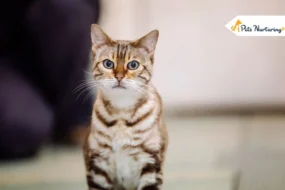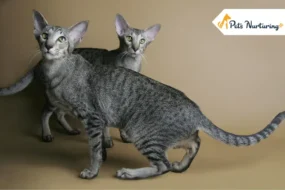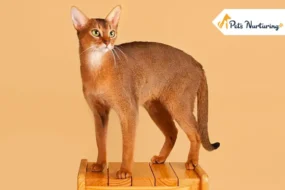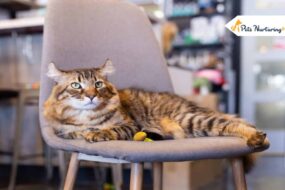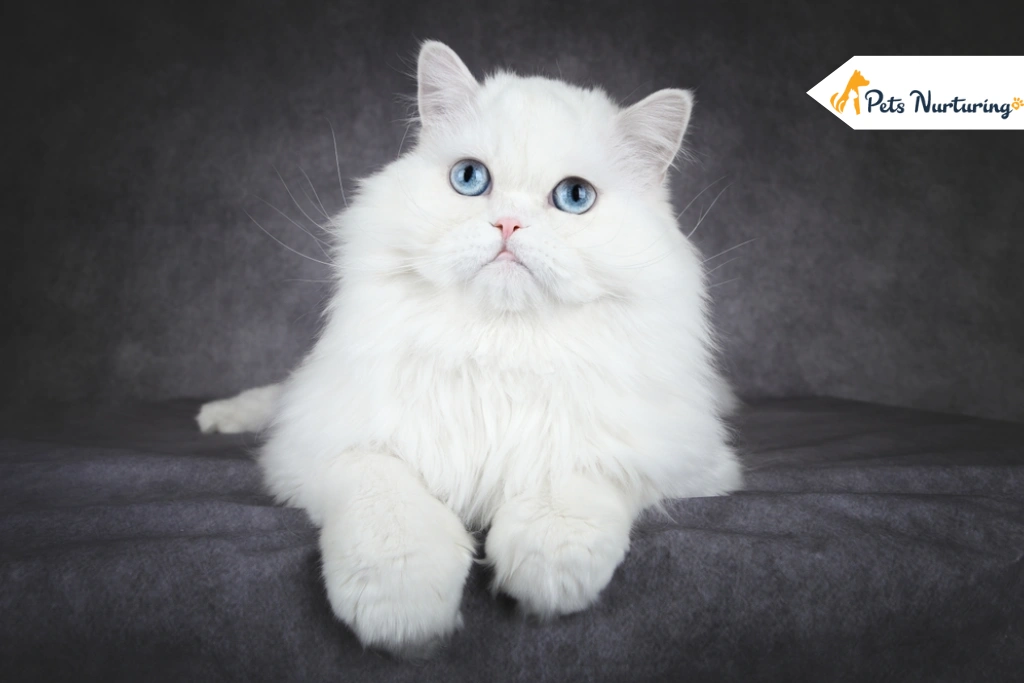
The Persian cat ranks among the most popular cat breeds in the world. These cats are the epitome of elegance and beauty with their silky long coat. But that’s not all; they have equally amazing natures. These cats are gentle, affectionate, and easy-going.
Originating from Iran (Persia), Persian cats gained widespread admiration by the 19th century. They are known for their luxurious coats, big expressive eyes, and distinctive flat faces. These cats make ideal companions with their loyal and even-tempered disposition. While they’re known for their relaxed nature, don’t be surprised by their occasional bursts of playful energy.
If you want to know more about this cat breed, keep reading. In this article, we are going to share all the important details about Persian cats – history, characteristics, temperament, health, and more.
Persian Cat Overview
Other Names: Persian longhair, Iranian cat, Shirazi cat
Length: 10 to 15 inches
Coat: Long, flowing, and luxurious
Coat Color: Available in various colors (Blue, white, black, red, cream, lilac, silver, chocolate, golden)
Temperament: Gentle, affectionate, and loving
Eye Color: Copper, green, blue, hazel, blue-green, and odd-eyed
Life Span: Around 15 to 20 years
Origin: Persia (modern-day Iran)
History
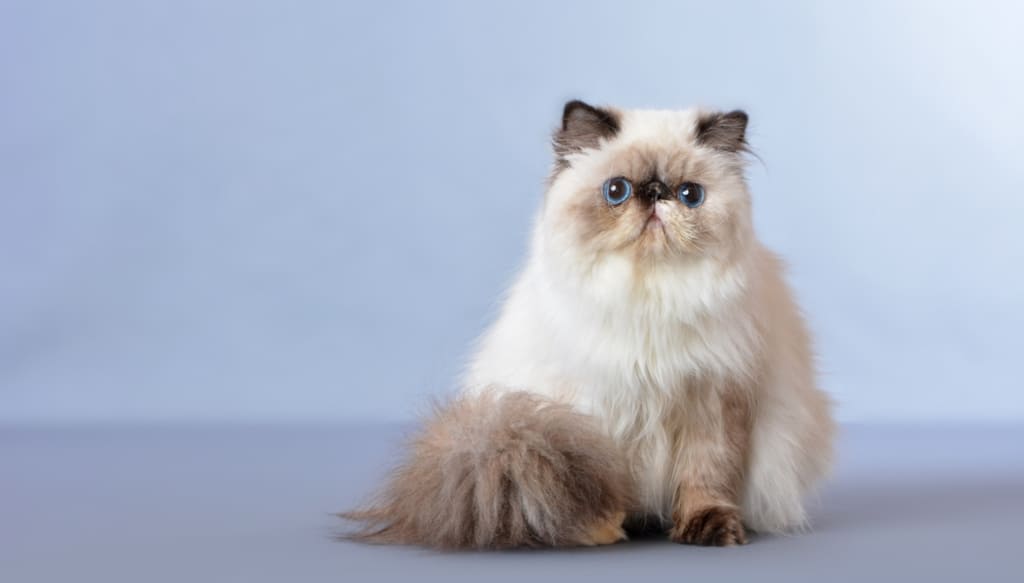
The Persian cat’s history dates back to the early 1500s, although some enthusiasts think it might be even older. Hieroglyphs from ancient times in the region hint at longhaired cats, possibly ancestors of the Persian breed.
The roots of the Persian cat stretch back centuries, with possible origins traced to regions like Khorasan in Eastern Iran or Western Afghanistan. Historical records suggest that these felines were introduced to Europe and other places around the 17th century.
Interestingly, the term “Persian cat” didn’t come from the Persian-speaking people themselves, who referred to these cats differently. Instead, the name was given in Europe to cats brought from Afghanistan, Iran, and nearby areas for marketing reasons.
There’s historical evidence that Persian cats were not only transported to Europe but also to India, emphasizing their popularity and trade across various regions. Despite their potential origins in Persia, genetic studies show that modern-day Persian cats have genetic ties to Western European cat populations like the British Shorthair cat, Chartreux, and American Shorthair.
The journey of the Persian cat gained public attention at the first-ever cat show in London back in 1871, showcasing early versions of these felines. Queen Victoria’s fondness for Persians boosted their popularity among other royals and the upper class in Britain. They soon found their way across the Atlantic to the United States, captivating the hearts of Americans just as they did in England.
By 1906, the Cat Fanciers’ Association recognized the Persian as one of its foundation breeds. Interestingly, within the Persian breed group, The International Cat Association acknowledges the Himalayan as a distinct breed. The Himalayan cats display light-colored bodies with darker “points” on their face, ears, legs, and tail.
Appearance
Persian cats are typically medium-sized, sporting big, expressive eyes and rounded ears atop a small head.
Typically, male Persian cats weigh between 10 and 12 lbs, while females are a bit smaller, ranging from 7 to 10 lbs. They are among the largest cat breeds in the world.
| Characteristic | Male | Female |
| Weight | 10 to 12 lbs | 7 to 10 lbs |
| Height | 10 to 15 inches | 10 to 14 inches |
Their distinctive features include a normal flat face or a more pushed-in appearance with soft, chubby cheeks. Both the “doll-face” and “traditional” Persians retain sharper ancestral features. They’re not known for their jumping skills but possess powerful bodies and sturdy legs, often preferring to keep all four paws firmly grounded or draped over furniture.
With their large, expressive eyes and gentle voices, these flat-faced cats crave affection and readily reciprocate it manifold. Their eyes come in shades of copper or blue, while golden or silver Persians often boast captivating blue-green or green eyes.
In terms of their physical build:
- They have a round-shaped head
- A short and thick neck
- A cobby body
- Thick and short legs
- Their paws are firm, round, and relatively large
The appearance of Persian cats differs depending on the type:
1. Doll-Face Persian Cat
Doll-Face Persians lack the distinct features commonly seen in show-type Persians. Their noses appear in a more typical shape, deviating from the pronounced characteristics associated with show Persians.
2. Show-Type Persian Cat
On the other hand, show-type Persians boast a simple, rounded head shape complemented by a lavish coat. They feature prominent traits, including a thick ruff, short, sturdy legs akin to tree trunks, a compact body with robust boning, and notable large, round, copper-colored eyes. Additionally, they display a flat nose, small ears, and the hallmark characteristics expected within the show Persian breed.
The largest cat painting in the world showcases Persian cats.
Coat and Color

Persian cats have remarkably silky and long coats. It comprises a soft topcoat and an undercoat, which can lead to some shedding.
Each Persian is unique due to its distinct coat color and pattern. They come in a variety of colors and patterns. Persian cats are popular among black and white cat breeds. These cats are categorized into around seven solid color divisions, including:
- Black
- Blue
- Chocolate
- Cream
- Golden
- Lilac
- Red
- Silver
- White
There are also other color patterns like,
- Bicolor
- Particolor
- Tabby
- Calico
- Smoke
- Shaded
Each color variation adds to the individual charm of these delightful felines. If you are looking for grey and white cat breeds, you’ll often come across Persian cats.
Characteristics and Temperament
Persian cats are adored for their sweet and calm nature. They’re friendly but prefer gentle handling—no rough play or sudden grabs, especially from young children.
They enjoy being petted and admired more than engaging in energetic activities. They also get along well with considerate kids and, if introduced properly, with other cats and gentle dogs.
Persian cats have their favorite spots at home, like plush chairs or high perches, where they can keep an eye on everything happening around them.
Being homebodies, Persians prefer indoor living to avoid overheating or tangling their long coats. While they cherish their human families, they’re okay with being alone for short stretches as long as they’re in their cozy, safe space at home.
These cats have an endearing, almost childlike meow and are quite expressive with their eyes. They appreciate some alone time but love your company, which brings out their playful side and boosts their happiness.
Surprisingly, these composed cats can have sudden bursts of activity and are friendly, enjoying playtime with anyone willing to join in.
- They have a high affection level
- They are very friendly
- They can be medium-level friendly with kids
- They can tolerate other pets
- They have low exercise needs
- They are playful
- They have low energy levels
- They are very intelligent
- They are not really vocal
- They shed medium-amount of fur
Health and Nutrition
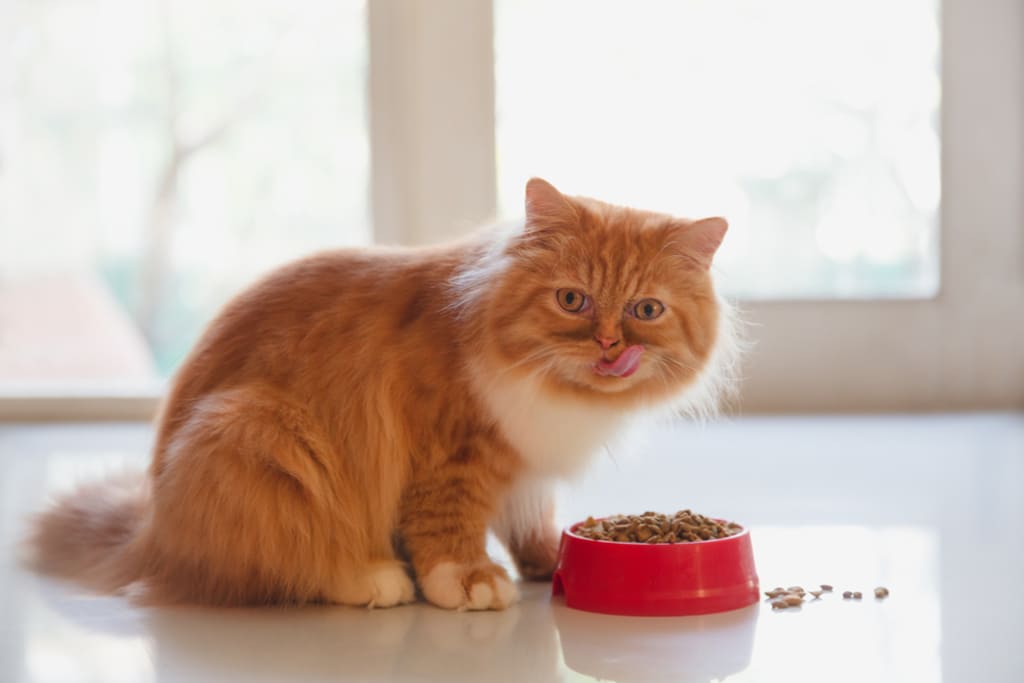
Persian cats aren’t the most active bunch and can easily gain weight, so it’s essential to keep an eye on their diet. To ensure your cat gets the right nutrition, pick complete, balanced food, meeting AAFCO guidelines for their life stage.
The amount you feed your Persian should align with their age, lifestyle, and ideal body condition. Your vet is the best guide for this, even though there’s a general calorie chart based on weight.
For added health support, your vet might recommend supplements like omega fatty acids to improve skin and coat health, which is particularly helpful for Persian cats with skin issues. Insoluble fiber supplements can assist with hairballs, preventing them from forming in the stomach or ending up on your carpet.
To manage your Persian food, offer measured meals twice a day instead of keeping the bowl full all the time. For young kittens, feeding three times a day is best. If you’re unsure about the right food or portion size, your vet or breeder can give you helpful advice.
Common Health Problems
Persian cats are prone to specific health problems like:
1. Hydrocephalus
Kittens with extreme brachycephaly might develop this condition, causing an abnormal buildup of fluid in the brain cavities. Signs like seizures, unusual head shape, breathing problems, or stunted growth may indicate this issue, requiring potential surgery.
2. Progressive Retinal Atrophy (PRA)
A genetic eye issue causes gradual blindness, starting with night blindness in younger cats. There’s no cure, but responsible breeders can provide genetic test results.
3. Skin and Coat Disorders
Their long fur can lead to skin problems like fungal or bacterial infections and need regular care.
4. Brachycephalic Airway Syndrome
Flat-faced breeds like Persians can have breathing issues due to narrowed nostrils, elongated soft palate, or small trachea. Labored breathing, especially mouth breathing, calls for immediate vet attention.
5. Polycystic Kidney Disease (PKD)
Genetic testing helps identify carriers and prevent kidney cysts in kittens. Symptoms include increased drinking, frequent urination, poor appetite, or weight loss, usually surfacing around 7 years.
6. Dental Disease
Persians, due to their flat faces, are more prone to dental issues. Daily teeth brushing and regular vet visits help prevent problems.
Knowing these risks and staying vigilant can ensure your Persian cat leads a healthy and happy life.
Behavior and Training
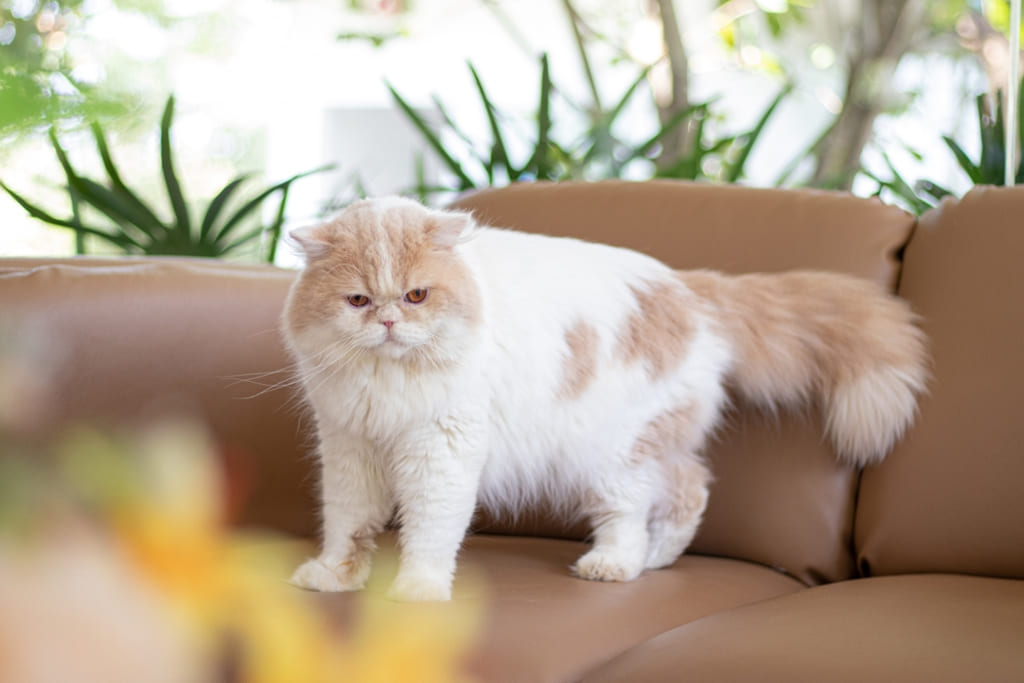
Persian cats are creatures of habit, loving a calm and quiet life. They’re sensitive to changes in their surroundings and usually do better in homes with older kids rather than with toddlers or babies.
When it comes to other pets, Persians can get along with fellow cats and gentle dogs, but introductions should be gradual and careful.
In terms of behavior, they’re not as talkative as some breeds, like Siamese cats, but when they do meow, it’s soft and sweet. They enjoy laid-back playtimes, lounging in sunny spots, or watching birds outside.
Training these intelligent cats is possible with positive reinforcement and a clicker, but success might vary depending on each cat’s personality, as well as the patience and dedication of their owner.
For fun, Persians adore sunbathing, lounging in comfy beds, getting petted and groomed, and engaging in gentle play. These activities keep them content and happy.
Exercise Needs
Persian cats may be calm, but they do enjoy playing with feather wands or other teaser toys. It’s good to engage them in a few play sessions daily to keep them mentally and physically active.
Scratching is a natural habit for cats, so it’s essential to guide them to the right spots. Set up approved scratching zones in your home, including tall posts or cat trees and flat cardboard or sisal scratchers. This gives your cat various ways to scratch and helps save your furniture.
Persian cats are as friendly as dogs, but they are pretty lazy too.
Grooming Needs
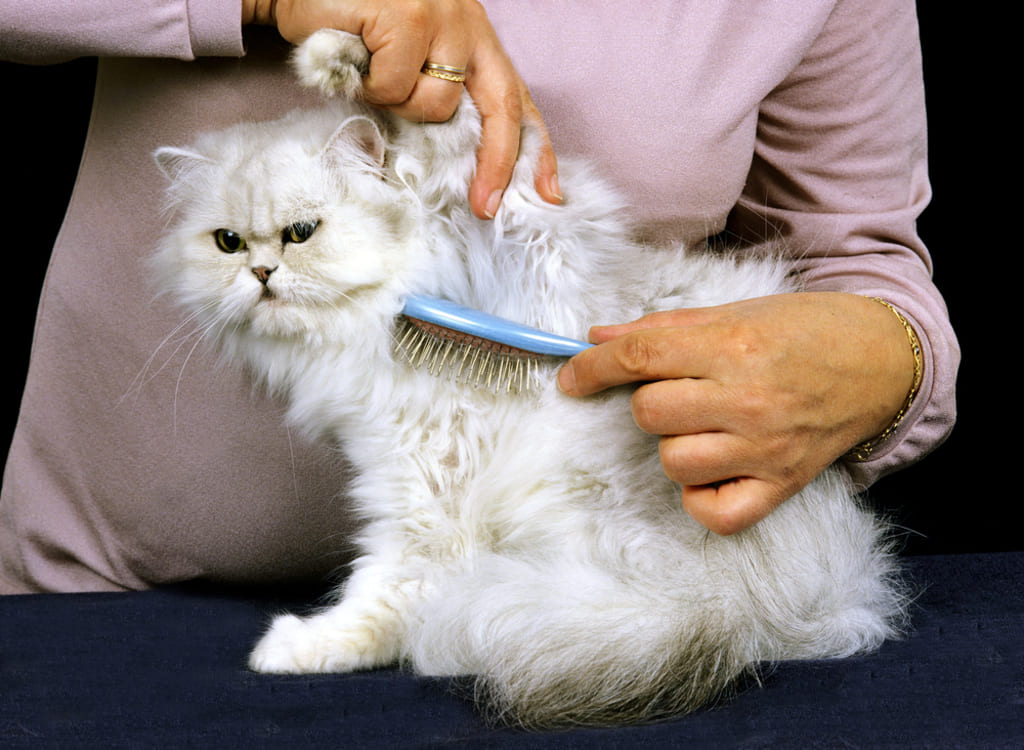
Persian cats are considered high-maintenance due to their long and silky coat. Here’s how you can groom them:
Brushing
Use a metal wide-toothed comb daily to prevent matting, focusing on gentle strokes from head to tail. Target tricky areas like behind the ears, under the chin, stomach, and legs.
Bathing Routine
Bathing should occur every two months, considering their dislike for water and indoor lifestyle. However, adjust if necessary, especially if you suffer from allergies.
Ear Maintenance
During grooming, check ears for oil or dirt buildup and use an ear cleaner with a cotton ball. If there’s any unusual odor or discharge, consult your vet.
Eye Care
Gently wipe their eyes with warm water or a vet-recommended solution once or twice daily to avoid eye discharge buildup and infections.
Nail Trimming
Trim nails every few weeks, especially the front claws. Take care not to cut too deep, especially with the slower-growing back claws.
Dental Hygiene
Regularly brush their teeth to prevent bad breath, periodontal diseases, and tooth loss, ensuring overall health.
Are Persian Cats Hypoallergenic?
Persian cats, unfortunately, aren’t hypoallergenic. For many allergy sufferers, being around them can be tough on their throats and skin.
Here’s why they’re not hypoallergenic:
- They have double coats that shed moderately all year round.
- They produce a lot of dander, which can trigger allergies.
- They tend to slobber moderately, exposing people to saliva.
- They produce moderate to high levels of fel d1, a common allergen.
Price
Persian cat prices fluctuate based on various aspects like age, breed, lineage, and health. Typically, Persian kittens for sale can be anywhere between $500 and $2,000. However, rare bloodlines or exceptional traits can drive prices well over $10,000 for high-quality Persians.
Life Span
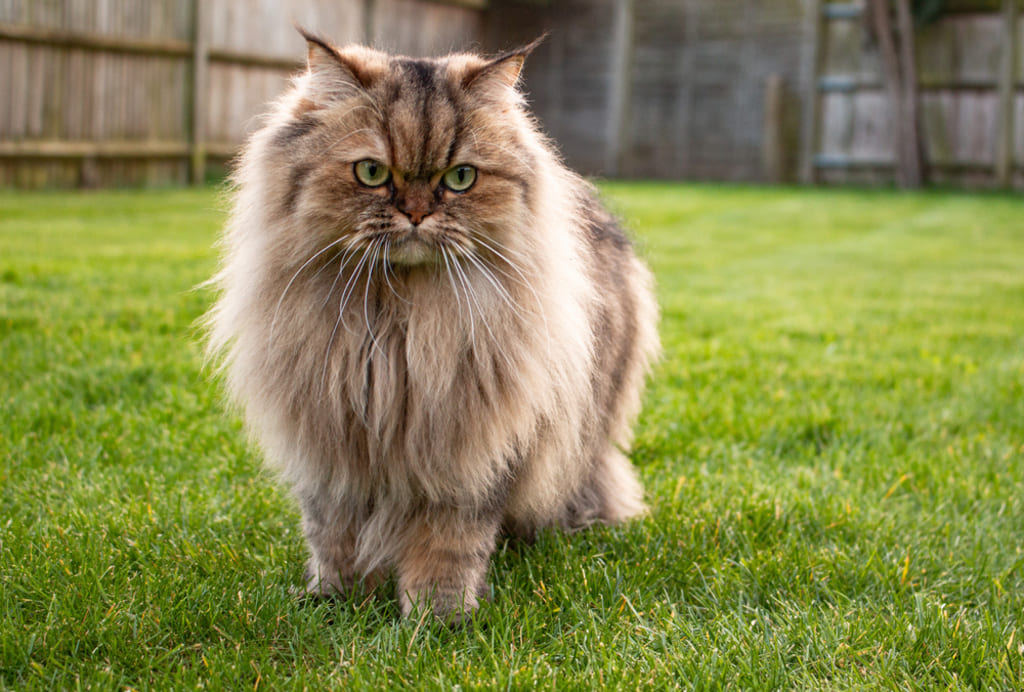
Persian cats, like many other feline friends, usually live around 15 years. Yet, some Persians have been recorded to reach an impressive 20 years. A Persian’s lifespan can be influenced by various factors such as genetics, diet, surroundings, and overall health.
FAQs
You can search online and find a local breeder in your area to buy a Persian cat.
It is a Persian cat with a blue color coat.
No, they are not rare, as you can easily find them with breeders.
Persian cat price depends on their coat color and quality. You can easily find a white Persian cat for sale for around $1,000.
Conclusion
If you are looking for a domestic cat with striking beauty and gentle nature, a Persian cat is the right choice. These cats are known for their sweet disposition and can easily live in families. If you train them well, they can also get along with kids and other pets. The best thing is that they don’t need much attention as they spend most of the time lounging around. However, make sure you give them a proper diet and take them for regular vet checkups to avoid any health problems.
In Case you Missed it:








